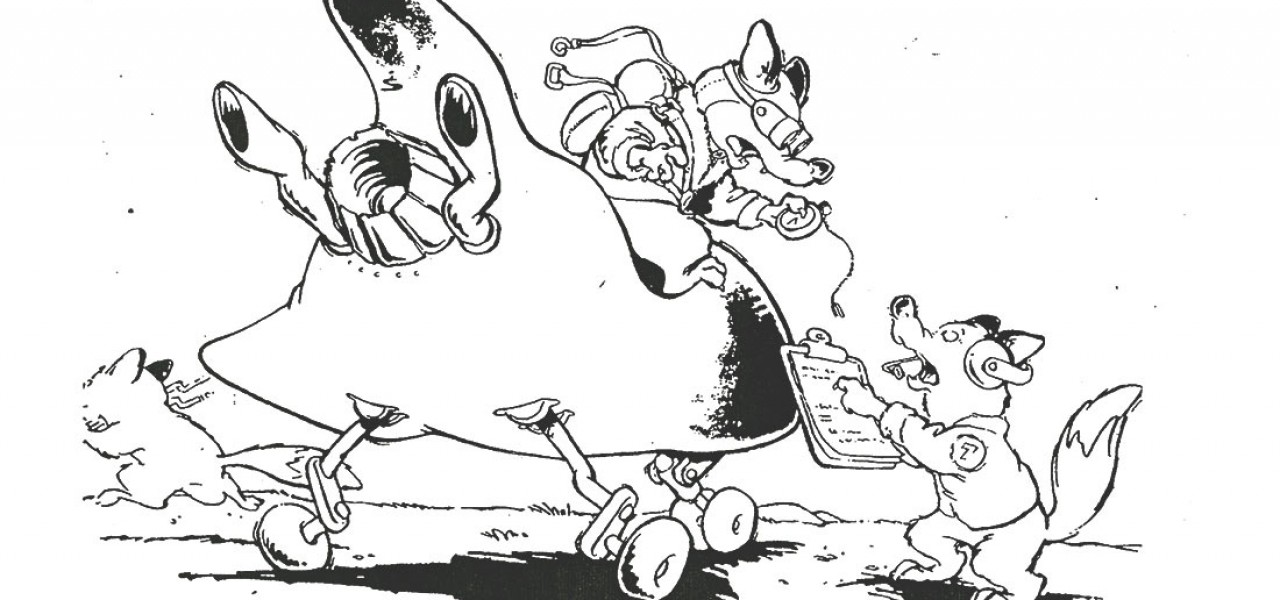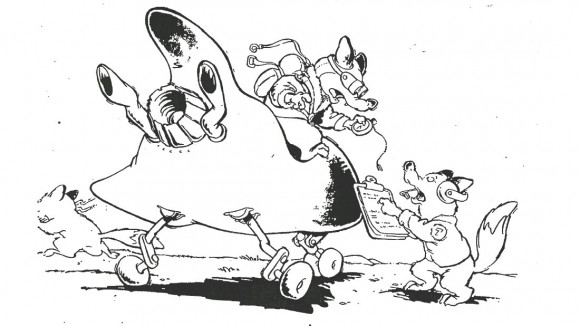

Read the Chris Sanders Storybook About What Was Wrong At Disney in the 1980s
Brew reader “Test Pilot” was looking through his copy of The Illusion of Life when he stumbled onto some Xeroxes circa 1989 tucked inside of the book. The story and artwork, which he posted on his blog, is by Chris Sanders, director of Lilo & Stitch and How To Train Your Dragon. It’s called The Big Bear Aircraft Company, and of course, the drawings ooze with typical Sanders appeal.
But this isn’t any normal story concept. The sub-title is “A Book for the Big Retreat.” And the story is an allegorical tale about the animation industry. The message is loud and clear: a management-heavy, writer-driven animation studio will be doomed to produce safe and unoriginal animated films. His devastating takedown of writers is notable; he doesn’t even bother extending a metaphor to them and bluntly depicts their uselessness in his story’s setting, which is an aircraft factory:
The writer likes airplanes; he saw one on TV once. He has actually never worked on one before, and couldn’t tell you for sure what makes one fly. But now he’s got the idea, and is hammering away at an incredible rate. . . . Without the visual engineer’s guidance, the writer is guaranteed of making the same mistake every time. He will make his airplane look like every one he’s seen before, and he will power it with a plot and dialogue engine, the biggest and heaviest he can find.
Here’s the full piece:












The document raises a number of fascinating questions that perhaps Chris or someone else familiar with the document’s origin can answer. For example, what retreat was this created for, who saw the document originally, have Chris’s views changed or evolved in the past couple decades, and most importantly, did anybody listen to Chris’s passionate plea to trust the artists?
UPDATE: Chris Sanders wrote two detailed comments on Cartoon Brew about the book. In the first comment, he clarified the purpose of the book and the ideas contained within it:
Golly, I never thought I’d see that thing on the internet. I really wish I could re-do those drawings right about now.
I read some of the comments earlier, and I think I can provide some perspective as to what I was up to, and what was happening at the time I wrote this.
It was created for a Disney offsite. I wasn’t invited to the retreat, but anyone could write their thoughts down and submit them, and they would be copied and bound into a folder that would accompany the attendees. The hope being that all this stuff would be read carefully and thoughtfully and then discussed by the attendees at the retreat.
I wanted to submit some thoughts of my own, but from the size of some of the notes being submitted by my fellow artists, I thought it was unlikely anyone would really read all that material. We’re talking dozens if not hundreds of pages of thoughts/complaints/suggestions in that folder.
So I decided to submit mine in the form of this little picture book — so it might stand out. I’m not sure if it worked, but if someone found a copy of it twenty years later, at least one person must have read it.
Anyone who read the story would see that I wasn’t a proponent of the removal of writers from the development process. But I was focusing on the quantity of writers, the quality of the writers, and the unwillingness of writers to partner with the artists they worked so near. And, I would say, the artists they needed to make their material work. In feature animation a great deal of the finished film, if not the bulk of it, is written by the story crew. And I mean entire scenes, not the occasional gag that is transcribed back into a script. As head of story on Mulan, I received a writing credit for that very reason.
The other thing I was concerned about was the ever-growing complexity of our films, and what I saw as an emerging pattern they were all cut from. A lot of our films fell into a well-worn groove. Different characters, but similar roles. It didn’t seem like we could get away with that forever. I felt we could be more inventive. I felt that a film with a smaller crew and lower budget could be successful.
While the story crew was debating how we would kill the villain at the end of Mulan, we began reflecting on how strange it was that we spent so much time trying to find fresh ways to kill characters in Disney films. In Mulan we (the story crew) came up with the idea that the villain could be blown to bits by fireworks, rather than falling to his death as was written in the script. A lot of those villains fall at the end of Disney films. Some get stabbed first, but a whole lot of them fall. There was almost always a death at the end of our movies. It was one of those patterns I worried about.
That’s where Lilo and Stitch came from. At its base, Lilo and Stitch is a story about a villain who becomes a hero. A redemption story. A story that diverged from the pattern.
At the time I wrote that document, the suggestion that Disney could be surpassed by another studio seemed outrageous. Impossible. But a studio or company that feels secure, is slow to innovate and has trouble with self-examination can certainly be surpassed by something fresh, small, and fast.
Anyway, that’s where the little story book came from. To my surprise, it made the rounds. In the years that followed I got the occasional call from people at other companies that asked if they could use it for a presentation. I guess it was vague enough that it could apply in other places. Including Lockheed, to my surprise.
In the second comment, he elaborated on the role of writers in animation:
I’m glad this forum has generated such passion – it’s so nice to hear so many perspectives. The only thing I’d add at this point, is that I don’t assume anything about writers. All my experience with the writers I was referring to was first-hand.
Again, I like writers. The good ones. The ones that aren’t just good at structure or inventive dialogue or the rhythm of a scene – but the ones that are also good in a room. The ones that are friendly, energetic and collaborative. The ones that can adapt quickly to a change and don’t have a problem editing their own pages. The ones that think visually, and understand when to let the characters shut up and let the score do the talking. And the ones that do their job without arrogance or ego. One thing I’ve learned – if someone tells you they are a great writer, they probably aren’t a great writer. At the very least they are a writer who’s better off mailing their pages in because you probably don’t want them around.
When I talk about writers I’m talking about the ones I actually worked with. In development my room was right next to theirs. A whole slew of different writers passed through that room – none of them stuck around very long. Some were silly, some were lazy, some were arrogant, and some were just plain mean. One group yelled at our PA because their phone cord wasn’t long enough. Another set spent the entire day wadding up fresh pieces of typing paper and throwing them at a wastebasket till it was buried, then took a three hour lunch. They came back for an hour before they left for the day. One came into my room, complained about my drawings, then took a piece of paper from me and scribbled the most terrible little drawing. He gave it to me and said, “There, that’s how the villain should look.”
Boy, I wish I kept that drawing. Once, while in a very tense meeting, our writer banged their head on a table, burst into tears, and ran out of the room.
And I listened to them all day long. That’s why I wrote what I did about them. I actually heard the stories they were hatching. It was pure insanity. The Sound Of Music set underwater with Nazi sharks. I saw them watch a Goofy cartoon and one of them asked why Goofy was acting so dumb. They thought they could probably fix that, because, well, I guess they thought the way Goofy was acting must have been some sort of mistake.
The ones I worked with, especially in development, didn’t belong there. They had no love for animation. In fact there was usually contempt for it. They wasted our time, money, and seriously stressed everyone out because we fretted that one of them might actually be assigned to one of our films and we’d have to carry them all the way through.
We wondered where they all came from. When you bought a typewriter did a certificate fall out that said, “Congratulations! You are now a writer. Take this certificate to your nearest studio where you can redeem it for a job.”
To the fellow who joked that I should have hired a writer for my story, I would say it already had one – me. I thought it up. I wrote it. And I drew it. It may not be perfect, but it exists solely because I made it. And it still seems to have some ability to start conversation, which is what I wanted it to do when it was written twenty years ago.
The implication of course that a “real” writer could have done it better. But as usual, when I was making it, there weren’t any around. All the “real” ones had gone home at 4:00. So I did it. And it got done.
One final note – I’ve written scripts and I’ve drawn story boards. I’ve even boarded my own pages. And when I board my own pages I change about the same amount of stuff I do when working from other writers pages. Even I can’t foresee all the adaptation a scene will need until I actually start drawing it. So if you’re writing for feature animation, don’t be too quick to feel upset if things get changed in boards. As soon as I sit down to board my own pages, I’ll think, “Well this doesn’t work.” Or, “I can dump half of this, what the hell was I thinking?”
Boarding is physically more demanding than writing. It just is. Write a battle scene, then try boarding it. A single paragraph of a script can stretch into hundreds of drawings. Feature animation is ultimately written on the boards. Pixar, Disney, Dreamworks, are all massive collaborations. Scenes are written, boarded, pitched… and then the real work begins. Those meetings can last days, and the story artists, directors, and writers are all in that room together. Writers return to their computers alone, but they are carrying all the material generated in those story meetings. So be careful not to imagine a pristine process where a writer sends pages along, and they simply get made into a movie.

